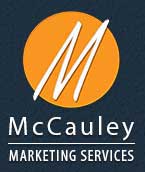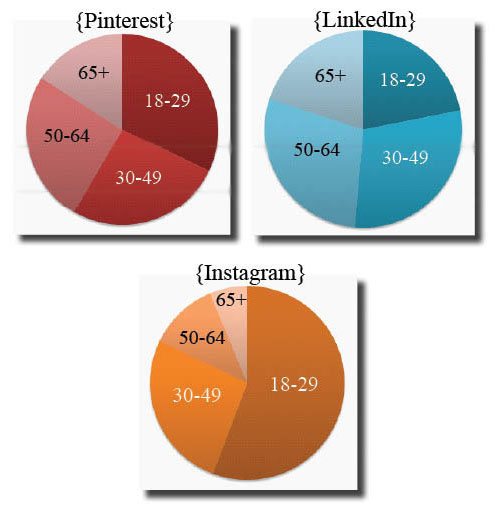Beyond Facebook and Twitter: Marketing on Smaller Social Media Platforms
It’s no secret that at McCauley Marketing Services, we see the value of social media marketing—it’s a low-cost way to reach large numbers of consumers at once and to build the type of relationship that leads them to your door. But for many businesses, a social media strategy only involves Facebook and Twitter. That’s a great start, and it’s important to regularly post to both of these sites, but you may be overlooking some other valuable social media platforms. Pinterest, Instagram, LinkedIn, and YouTube aren’t discussed as often when it comes to social media marketing, but they each offer a great opportunity for the right businesses to interact with their consumers.
What is it?
Pinterest is a digital “pinboard”—just like we used to cut out pictures, recipes, or articles and pin them to a corkboard for future reference, Pinterest allows users to do this with online media. Users can install a button on their web browser’s toolbar, and when they see something they want to share or bookmark for later, they can pin the image (which links to the original web page) onto one of their categorized pinboards, and it’s posted for all their followers to see as well.
Who uses it?
Women use Pinterest significantly more than men, but their users are fairly evenly distributed among ages 18-64. Most Pinterest users are also college graduates with a high household income.
How can I use it to market my business?
As with any marketing medium, not all businesses will notice a return on their investment when they use Pinterest. Many users browse through their newsfeed for quick ideas or articles that peak their interest, so it’s generally more valuable for companies who sell smaller items than those with pricier products or services. For instance, an online health food store will likely see more web traffic from Pinterest than a plastic surgeon will. For businesses like these plastic surgery offices, Pinterest is more important as a consideration for your website. Pinterest users can only pin a page if it includes a usable image, so be sure that each page has an attention-getting, relevant image. Otherwise, your site is closed to the opportunity for your supporters on Pinterest to spread the word about you.
For companies who can benefit from Pinterest, it’s important to avoid over-promoting—as with any social media platform, if your Pinterest activity reads like one big sales pitch, your followers will likely get annoyed and stop following you. Instead, make sure you intersperse pins about your business with pins that your followers will find relevant and interesting.
What is it?
Like Pinterest, Instagram is an image-focused medium, but instead of users posting images they’ve found from various websites, users post photos they’ve taken of their own lives.
Who uses it?
Instagram is highly popular among young adults (especially college students), with the majority of its users being between the ages of 18 and 29. While other social media platforms have users in a wide variety of age groups, Instagram has a much more specific demographic, as illustrated in the chart below:
How can I use it to market my business?
One of the biggest advantages of social media is that it allows your business to build a friendly, trusting relationship with your consumers, and for certain companies, Instagram can be a perfect medium for this goal. As with Pinterest, be cautious to avoid posting too much and focusing too many of your posts on sales-driving rhetoric. Post photos that bring your followers behind the scenes to help them feel like a part of your company. For example, post pictures of your office celebrating staff birthdays, or photos of your production process. You can also give users a sneak peak of upcoming products or services, which will further endear you to them because you’re letting them feel like an insider. But before you start snapping photos left and right, consider whether the somewhat narrow demographic of Instagram’s users are people who can benefit from your products and services. For instance, a medical spa or dermatology office that focuses on skincare and skin health tips could see significant potential benefits if their strategy is purposefully developed and well-executed.
What is it?
If Pinterest and Instagram are social butterflies, LinkedIn is their more studious sibling. This social media platform uses a similar format to Facebook (each user has a page with their information and recent posts, and all their connections’ posts—most of which are word-based as opposed to image-based—are shown on a news feed), but focuses solely on professional networking.
Who uses it?
Unsurprisingly, LinkedIn users are generally career-focused individuals: college graduates between the ages of 30-64 with a high household income.
How can I use it to market my business?
Your marketing strategy on LinkedIn should be very different from your strategy on other social media platforms. In fact, this site should be used primarily to network with relevant professionals, rather than to market your company to the general public. Your networking should focus on other business professionals that you can cross-refer with. For instance, a pediatrician would be wise to develop a relationship with a general physician. When the physician’s patients are looking for a pediatrician for their children, their physician can refer them to the pediatrician they’ve developed a trust with, and the pediatrician can do the same for patients who begin to reach adolescence and adulthood.
YouTube
What is it?
YouTube places less of an emphasis on the “social” part of social media and focuses solely on video-sharing. While anyone can visit the site and watch videos on nearly any subject (from tutorials to comedic clips), each user can also have their personal channel where they can post their own original content. Users can interact with each other through comments on videos as well.
Who uses it?
With 63% of internet users visiting the site, YouTube is currently one of the most used social networking sites, second only to Facebook. While YouTube users span all age groups, their most popular crowd is young adults between 18 and 29 years of age. In fact, 82% of internet users in this age group are YouTube users.
How can I use it to market my business?
With the wide variety of videos that are viewed and posted on YouTube, the marketing possibilities are abundant. For professionals who want to improve their image as a trusted expert in their field, such as a plastic surgeon, videos of you (the professional or provider) discussing commonly asked questions or popular topics can be a great way to increase your visibility. As we’ve mentioned previously, social media can help you build trust with your consumers, which is especially important for companies whose products or services are more expensive or require a significant commitment from the consumer. YouTube videos give you an opportunity to essentially have face time with your consumers while they’re still in the “researching my options” phase, which can be key in becoming the trusted professional they turn to when it’s time to make a decision.
Social media is an essential part of a diversified and maximized marketing plan. Facebook may still have the largest number of users, but now more than ever, adults are using multiple social media platforms. For the right businesses, a well-planned and executed marketing strategy on Pinterest, Instagram, LinkedIn or YouTube can be a great resource. As each of these social media platforms continue to change their strategies and algorithms, their implications for businesses will change as well. Working with an experienced marketing team to build your presence on these smaller sites now is an investment that could pay off in the short-term and long-term as these sites continue to grow in popularity. To learn more about how social media marketing can benefit your business, schedule a meeting with us or join us on Facebook, Twitter, and Google+.

